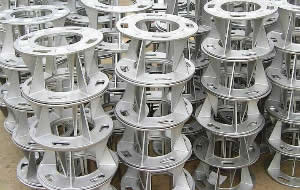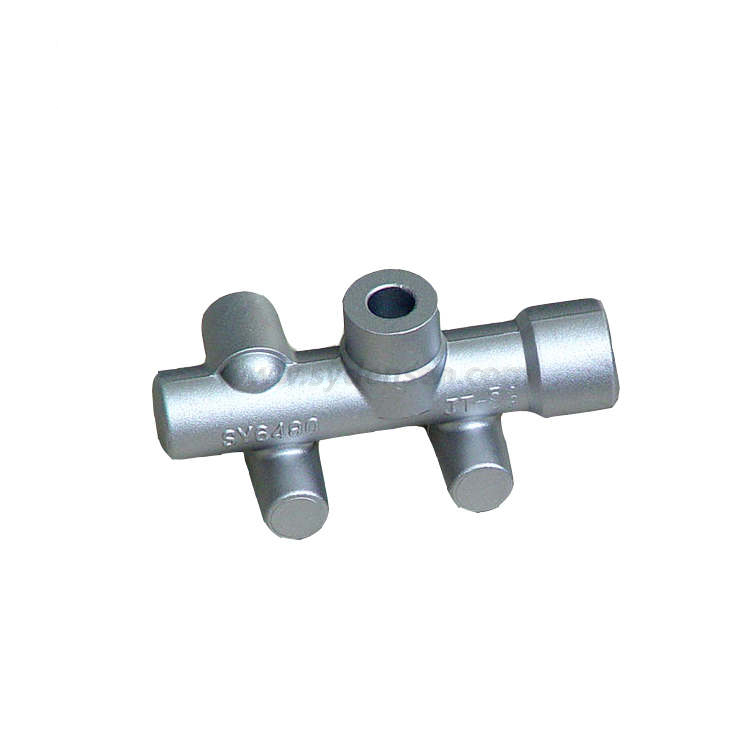Sustainability Factors of aluminum casting and How Recycling Helps
Aluminum Casting Explained: Secret Truths and Insights for Industry Professionals
Aluminum casting offers as an essential procedure in modern production, forming elements across numerous markets. Its varied approaches, such as sand and die casting, satisfy different manufacturing requirements. The distinct residential or commercial properties of aluminum alloys boost their applicability, yet tests stay in preserving high quality and efficiency. Recognizing these elements is crucial for market experts. What are the most recent developments and best practices that can additionally maximize this process?
Review of Aluminum Casting Processes

Crucial element of aluminum casting procedures consist of the prep work of mold and mildews, which may be made from sand, metal, or ceramic products, relying on the intended use. Furthermore, temperature level control is important to ensure proper melting and solidification of aluminum.
The casting process permits elaborate designs and can achieve high levels of dimensional precision. When cooled down, the spreadings may undergo ending up operations such as machining or surface area treatment to fulfill particular performance criteria. Generally, aluminum casting offers as a flexible manufacturing technique, successfully fulfilling the diverse requirements of different markets.
Kinds Of Aluminum Casting Approaches
In the domain of aluminum casting, different techniques are employed to achieve various outcomes. Sand casting methods provide versatility and cost-effectiveness for complicated forms, while die casting processes use high accuracy and effectiveness for mass manufacturing. Understanding these methods is vital for selecting the proper technique based on task needs.
Sand Casting Strategies
Sand casting methods stand for a fundamental approach in aluminum casting, where sand is made use of as a mold product to form molten steel. This process includes creating a pattern from the desired part, which is after that positioned in a sand blend to create a mold. The sand is compacted around the pattern, and after removal, it develops a tooth cavity in the shape of the part. Molten aluminum is poured into this tooth cavity, allowing it to cool and solidify. One considerable advantage of sand casting is its adaptability; it can fit huge components and intricate forms. In addition, the products utilized are fairly low-cost, making it an easily accessible option for different production applications in the aluminum industry.
Die Casting Processes
Die casting procedures are a famous method for forming aluminum parts, making use of high-pressure strategies to require liquified steel into exactly crafted molds. This procedure is specifically preferred for its capability to produce complex shapes with limited resistances and a smooth coating. There are 2 primary sorts of die casting: warm chamber and cool chamber. Warm chamber die casting appropriates for metals with reduced melting factors, permitting faster manufacturing prices. On the other hand, cold chamber die casting is perfect for higher melting factor steels, calling for a different melting furnace. Both techniques improve efficiency and lower product waste, making them essential in automotive, aerospace, and durable goods sectors. Recognizing these processes aids specialists pick one of the most ideal technique for their details applications.
Material Feature of Aluminum Alloys

Stamina and Durability
Stamina and resilience are vital attributes of aluminum alloys that make them suitable for numerous casting applications. These materials exhibit a positive strength-to-weight proportion, enabling the production of light-weight yet robust components. When it come to tensile strength, certain aluminum alloys can be engineered to endure considerable loads without flawing. This residential property is specifically crucial in sectors such as aerospace and automotive, where performance and safety are see it here paramount. Additionally, aluminum alloys usually retain their mechanical properties under varied temperature level conditions, ensuring constant efficiency. The innate ductility of these alloys likewise enables effective shaping throughout the casting process, making it easier to create complex geometries. Overall, the toughness and longevity of aluminum alloys add greatly to their prevalent usage in sophisticated applications.
Deterioration Resistance Characteristics
While aluminum alloys are treasured for their toughness and lightweight residential properties, their corrosion resistance is one more essential feature that enhances their viability for various applications. Aluminum normally forms a safety oxide layer when subjected to dampness, which helps to stop additional oxidation. This fundamental property makes aluminum alloys especially beneficial in environments susceptible to deterioration, such as aquatic and commercial settings. In addition, different alloy structures can affect resistance degrees, with particular alloys specifically crafted to improve this characteristic. Treatments like plating can further improve corrosion resistance by enlarging the oxide layer. Comprehending the deterioration resistance of aluminum alloys is important for market experts when picking products for tasks requiring resilience and long life in difficult atmospheres.
Advantages of Aluminum Casting in Manufacturing
Aluminum casting offers various advantages in production, making it a recommended option for numerous industries. One significant benefit is its lightweight nature, which adds to decreased transportation costs and boosted energy effectiveness in output. In addition, aluminum's superb thermal and electrical conductivity enhances capability in applications calling for heat dissipation or electrical transmission.
The product's capability to be cast right into complex shapes enables style adaptability, decreasing the need for added machining processes. In addition, aluminum casting displays superior deterioration resistance, resulting in longer product life-spans and lower maintenance expenses.

Common Applications of Aluminum Castings
The adaptability of aluminum casting enables its prevalent use throughout different industries. Typical applications consist of vehicle parts, where lightweight and corrosion-resistant parts, such as engine blocks and transmission housings, boost lorry efficiency. In the aerospace sector, aluminum spreadings are used for structural parts, using strength without adding considerable go to these guys weight.
Additionally, the electrical industry benefits from aluminum spreadings in producing rooms and heat sinks, where thermal conductivity is necessary. The consumer goods market likewise includes aluminum castings in items like cooking equipment, furniture, and decorative products, integrating looks with capability.
The construction sector employs aluminum spreadings for architectural elements, window frames, and components, which offer longevity and style versatility. Generally, the varied applications of aluminum spreadings underscore their importance in modern manufacturing, adding to advancements in efficiency and product style throughout numerous fields.
Advancements and Technical Developments
As industries remain to advance, developments in aluminum casting modern technology are changing manufacturing processes and product abilities. Developments in 3D printing and additive production have actually enabled the production of complex geometries that were previously impossible to achieve with conventional methods. These modern technologies enable quick prototyping, minimizing preparations and expenses.
Additionally, renovations in mold layout and products have enhanced the casting procedure by raising performance and decreasing waste. The combination of clever manufacturing methods, such as IoT devices and real-time data analytics, permits much better tracking and optimization of production criteria, causing better outcomes.
Furthermore, growths in aluminum alloys provide enhanced toughness, rust resistance, and light-weight residential or commercial properties, providing to the growing demands in automotive and aerospace sectors. Jointly, these innovations are not only enhancing productivity yet likewise satisfying the rigorous criteria of modern-day engineering applications.
Best Practices for Quality Control in Aluminum Casting
Guaranteeing high-quality outcomes in aluminum casting needs adherence to finest techniques that encompass numerous phases of the manufacturing procedure. Thorough product inspection is essential to confirm the top quality of aluminum alloys used, as contaminations can site here significantly impact the final item. Carrying out accurate melting and putting methods decreases problems; maintaining ideal temperature levels protects against oxidation and advertises harmony.
Furthermore, mold design plays a vital function; utilizing computer-aided layout (CAD) can boost precision and decrease human mistake. Regular monitoring of the cooling procedure is critical to avoid warping and contraction. Furthermore, using non-destructive screening approaches, such as ultrasonic or X-ray examinations, helps determine internal problems without harming the components.
Lastly, establishing a responses loophole with engineers and operators promotes constant enhancement, guaranteeing that quality assurance procedures advance along with technological developments. By complying with these best practices, makers can boost the integrity and efficiency of aluminum castings.
Often Asked Concerns
What Are the Ecological Effects of Aluminum Casting?
The environmental impacts of aluminum casting consist of significant energy intake, greenhouse gas emissions, and potential water pollution from shop procedures. Furthermore, bauxite mining for aluminum ore can bring about habitat destruction and soil degradation.
Exactly How Does Aluminum Casting Contrast to Other Steel Casting Processes?
Aluminum casting typically uses advantages in lightweight components and rust resistance contrasted to other processes, such as iron or steel casting, which might give greater toughness however lead to larger and less corrosion-resistant products. - Aluminum Foundry
What Prevail Defects in Aluminum Castings and Their Reasons?
Typical defects in aluminum spreadings include porosity, shrinkage, and additions. Reasons usually come from inappropriate pouring methods, inadequate mold and mildew layout, or contamination of the liquified metal, impacting the end product's stability and efficiency.
What Safety Preventative Measures Should Be Taken Throughout Aluminum Casting?
During aluminum casting, essential safety and security preventative measures include putting on protective gear, making certain correct air flow, maintaining a tidy work space, managing liquified metal with care, and complying with recognized methods to reduce threats of burns, breathing risks, and mishaps.
Just How Can I Improve the Performance of My Aluminum Casting Procedures?
To improve effectiveness in aluminum casting operations, one ought to maximize mold design, enhance material handling, utilize automated processes, carry out routine upkeep on equipment, and invest in worker training to boost skills and productivity.
Different approaches exist, aluminum casting includes several key procedures that cater to different applications and demands. Trick components of aluminum casting procedures include the preparation of molds, which might be made from sand, steel, or ceramic materials, depending on the intended use. Sand casting strategies stand for a basic method in aluminum casting, where sand is used as a mold and mildew product to shape molten metal. As markets proceed to evolve, developments in aluminum casting modern technology are changing manufacturing processes and product abilities. Ensuring premium outputs in aluminum casting calls for adherence to finest methods that incorporate various phases of the production process.